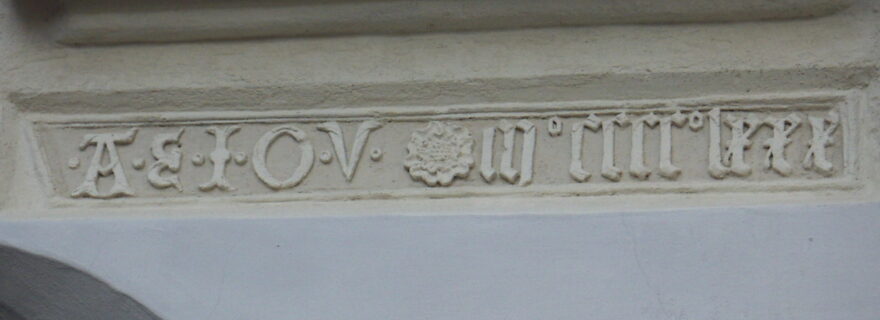A.E.I.O.U: Riddles in stone
In studying building inscriptions in the Netherlands, I came across some curious initialisms that are difficult to interpret and therefore intriguing. What to make of an inscription that says DOVK and nothing else, or a stone plaque showing a four-poster bed, the date 1591 and the letters IGDFC?
An early example of this strange practice occurred in 1437, when the emperor to be, Frederick duke of Styria (1415-1493), adorned various buildings with the underlined letters A.E.I.O.U. In a notebook, Frederick was so good as to explain why he did this: ‘Whatever building or silver plate or liturgical robe or other treasure shows the line and the five letters making up the device AEIOU is my property, Duke Frederick the Younger, or I caused them to be built or made’. Unfortunately, he was less clear about the meaning of his set of vowels. In the notebook, he provides two different interpretations, the first of which reads: ‘En, amor electis, iniustis ordinor ultor; Sic Fridericus ego mea iura rego’, which may be translated as: ‘See, I am loved by the elect, I am feared by the unjust; hence I, Frederick, rule legitimately.’ The second solution, which was added to the book later (maybe when Frederick started to have designs on the emperorship), has gained more popularity. It is either the German: ‘Alles Erdreich ist Österreich untertan’, or the Latin: ‘Austriae est imperare omni universo’ (the entire world is subject to Austria). As the interpretation is uncertain, scholars have surmised that Frederick was being playful on purpose, changing the meaning of the set of vowels as he saw fit, or that the motto was intended to be solved in various ways from the start.
Frederick’s motto may well have been triggered by the Roman motto SPQR, standing for the Latin ‘Senatus Populusque Romanus’, the Senate and People of Rome, which can be seen on buildings all over Rome. As Frederick was the first of the Habsburg dynasty to become Holy Roman Emperor, such a model was entirely fitting. On account of Frederick’s high station and the enormous range of Habsburg conquests, his mysterious motto attracted attention and became the model for other initialisms adorning buildings. In the Netherlands the vogue for letter puzzles is evident from the sixteenth century onwards, at which time the Habsburgs gradually started adding the Dutch territories to their empire.
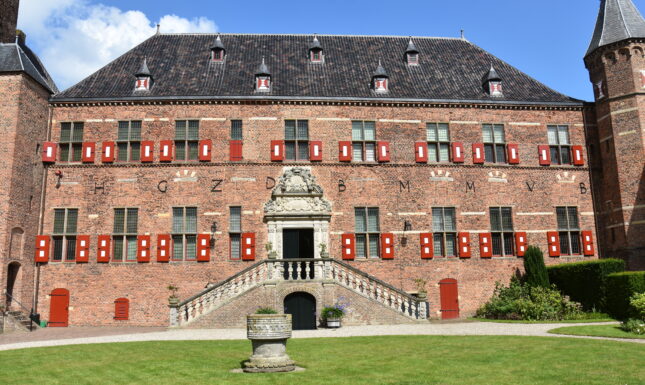

Frederick’s main concern in developing his motto was to indicate ownership. This concern is also apparent in the castle complex of ‘s-Heerenbergh, the estate of the Counts of Bergh. On the steward’s house, wall anchors forming the letters MGZDBMZBOZ refer to Count Herman van Bergh’s 1599 marriage to Maria Mencia van Witthem, marquise of Bergen op Zoom. The letters are an abbreviation of her name and titles: ‘M(aria) G(räfin) Z(u) D(em) B(erge) M(arkgräfin) Z(u) B(ergen) O(p) Z(oom)’. During the so-called Eighty-Year War, the family had to abandon House Bergh. On their return in 1610, they found it badly dilapidated and in need of repair. The ensuing restoration was commemorated by the letters HGZDBMMVB (again formed by wall anchors) on the façade of the main building, meaning ‘H(erman) G(raf) Z(u) D(em) B(erge) M(aria) M(arkgräfin) V(on) B(ergen)’. The great tower next to this building was fitted out with the letters HB, which are likely to refer to Herman van den Bergh. By putting his initials on the tower it was clear, already from a distance, that he was back in residence.
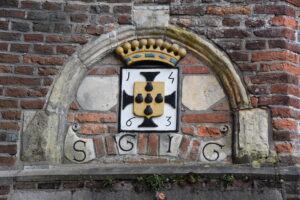

Frederick’s other concern, to show that he caused something to be constructed, is also manifest in some other Netherlandish letter puzzles. The combination JJVEHDESG found on the onion-shaped tower of the manor house in Ewsum (Groningen), destroyed in 1863, has been read as ‘Jonker Johan van Ewsum heeft de eerste steen gelegd’, ‘Squire Johan of Ewsum has laid the first stone’. A shorter example is to be seen on a stone relief set in the tympanum over the entrance to a stair-turret of the castle at Gemert. The relief is decorated with the black cross of the Teutonic Order with in its middle, under a crown, a yellow heraldic shield decorated with five scallops arranged in a cross form. In the corner are the numbers giving the date 1563. At the bottom, a scroll formed of alternate brick and freestone parts, supports the letters SGIG. The riddle posed by the letters can only be solved by reference to the inscriptions over the castle gate. The first of these reads ‘Anno . m.vc.xliij soe. is. dit. Werck. begonne[n]. in. gotsnam. met. vlijt / Heer. Wijnandt. van. brijel. lantcom[m]enduer. heer. tot. gemert. doe. ter.tijt’, thus indicating that work on the castle started in 1543 when Wijnand van Breyll was commander (from 1536 until his death in 1554) and Lord of Gemert. Below is another inscription, in capital letters, saying ‘SO. GOET. IS. GOT’ (so Good is God). This inscription solves the SGIG above the entrance of the stair-turret, which otherwise would have been undecipherable.
There are quite a few more of these mind-boggling letters to be found on Dutch buildings. On the inside of the church of Spijkenisse, against the east wall of the tower, is a stone plaque with the letters D.O.V.K and the year 1521, which supposedly means ‘door ordre van kerkmeesteren’, by order of the church wardens. In the village of Veenklooster, a small stone at the rear of a farm known as Woudboerderijtje (small farm in the forest) reads: D.T.D.P. 1561. This letter puzzle probably derives from the nunnery from which Veenklooster takes its name. The nunnery was founded in the thirteenth century and existed until after the Reformation. As the last prior was named Theodericus of Doetekum, the letters presumably mean ‘Dominus Theodericus de Doetekum Prior’.
Other letter combinations are easier to solve, as they represent variations on a known theme. In the city of Rhenen, the Roman SPQR became ‘Senatus Populusque Rhenensis’. Later on, in the sixteenth century, when the relations with the Habsburg rulership turned sour, a different interpretation of the letters was preferred, i.e. ‘Spaansche pokken quellen Rhenen’, which means ‘Spanish pocks plague Rhenen’, a sixteenth-century meme. In Dokkum the letters SPQD stood for the same thing: ‘Spaansche pokken quellen Dokkum’. The playfulness invoked can make solving such letter riddles very difficult, if not impossible.
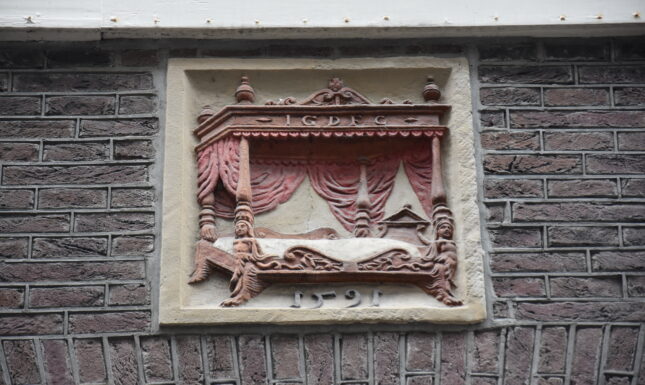

So far, I have only mentioned noble residences and ecclesiastical sites, but letter puzzles also occur on houses. On a modern building in the Sint Jansstraat 11 in Amsterdam is a (partially restored) relief showing an enormous four-poster bed supporting the letters IGDFC, with the date 1591 placed under the bed. The bed was copied after a print of circa 1530, made by the German Peter Flötner (1484-1546). The letters IGDFC have been read as ‘In Gloria Dei Filii Christi’ (in honour of God’s son Christ). One can only guess, why the bed was chosen to be the carrier of this particular initialism. Maybe the Dutch term for a four-poster bed, ‘hemelbed’ (bed of heaven) triggered the association.
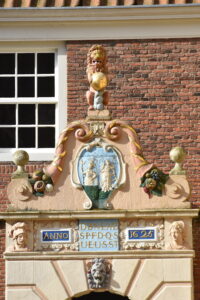

The longest letter combination I have come across is to be found on Wierdijk 13 in Enkhuizen, where the entrance portal of the residence of the Blaeuhulck family has been rebuilt. In between two cartouches with ‘anno’ and ‘1625’ there is a text relief with the letters:
D.B.N.E.A.D.
S.P.F.D.Q.S.
U.E.U.S.S.T.
These letters are thought to signify the initials of the words of the following moralizing rhyme: ‘Die benyt een ander syn profyt, Die quelt syn vleesch en verslyt syn tyt’ (if you envy another’s good fortune, you torment your flesh and you’re wasting your time). For those in the know it was probably very funny to see people attempting to solve the riddle.
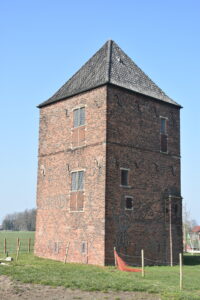
My favourite example comes from the floodplains of the river Rhine where, not far from the village of Haldern near Rees (Germany), the isolated Battenberger tower stands in a field that used to be known as the Buschkampshof. The tower’s ground plan measures circa 7 x 7 metres and it is around 15 meters high. It is thought to have been built in the early sixteenth century by Ameling von Eyscharden (of Esserden, near Rees) who was enfeoffed with the Buschkampshof by Duke Johann II of Cleves. The tower has decorated masonry on its east and south sides. On the east side (to the right on the photograph, in the shade) is the enormous figure of a helmeted ‘Landsknecht’, with puffed-up trousers and an awe-inspiring (but mutilated) codpiece that used to stand out defiantly. His left arm rests to his side, while his right arm has apparently just caught or is going to sling away a cannonball.
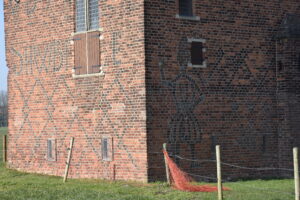

On the south side (to the left on the photograph) the decoration consists, among other things, of two rows of letters. Above are the letters VDM I AE. They have been read as ‘Verbum Domini Manet In Aeternum‘ (the word of the Lord is eternal), a reference to Jeremiah 40:8. However, another possibility is that the letters should be interpreted as follows: VDMI = 1506 and AE = Amelong Eyscharden. The row of letters below has DHWBI E, which could read as the German version of the Jeremiah reference: ‘Das Wort des Herrn bleibt in Ewigkeit‘. On the other hand, the same letters have also been read as ‘D(en) H(er) W(aer) B(ewoiner) I(ohan) E(yscharden)’. Although I don’t understand where the Johan in this interpretation comes from, it seems to me the two versions do not exclude one another. The whole idea behind these letter games is to show the beholder how clever you are and to set apart those who know the riddle’s meaning from those who do not. So, like Frederick’s A.E.I.O.U, these letters probably had multiple meanings.
These letter puzzles form a very small part of a research project dealing with building inscriptions in the northern Netherlands dating from prior to 1600, that is to result in a substantial book that I hope to finish this year.
Select sources:
http://www.ms-visucom.de/cgi-bin/ebidat.pl?id=2758
A. Lhotsky, ‚AEIOU. Die "Devise" Kaiser Friedrichs III. und sein Notizbuch‘, Mitteilungen des Instituts für österreichische Geschichtsforschung 60 (1952) 155-193.
© Elizabeth den Hartog and Leiden Medievalists Blog, 2022. Unauthorised use and/or duplication of this material without express and written permission from this site’s author and/or owner is strictly prohibited. Excerpts and links may be used, provided that full and clear credit is given to Elizabeth den Hartog and Leiden Medievalists Blog with appropriate and specific direction to the original content.


